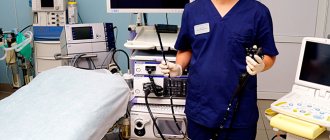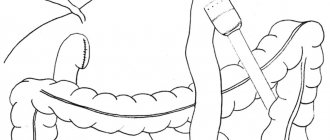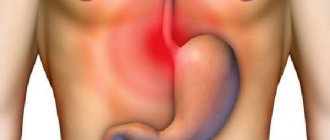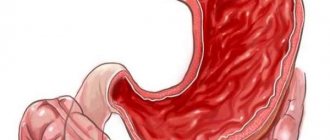Dumping syndrome - causes
In healthy people, food moves from the stomach to the intestines within a few hours. However, with early dumping syndrome, food particles move too quickly into the duodenum. This causes fluid to move rapidly in the intestines, causing discomfort, bloating and diarrhea.
Late dumping syndrome occurs when large amounts of insulin are released. Insulin
is a hormone that helps the body absorb sugars. Increased levels of insulin in the bloodstream lead to decreased blood sugar levels.
The most common cause of dumping syndrome is surgery. This condition occurs in at least 15% of people after undergoing surgery.
When should you see a doctor?
Dumping Syndrome has a lot of unpleasant symptoms. But the most dangerous thing in the absence of proper treatment is the rapid progression of the disease. Treatment in later stages is much more difficult. You should seek help from a doctor after gastric surgery if:
- you observe symptoms of dumping syndrome after gastric resection;
- signs appear, but you have not had stomach surgery;
- the body does not respond to the diet, no improvements are observed, although treatment is regular;
- As a result of your illness, you have lost a lot of weight.
Treatment in later stages is much more difficult
The doctor selects medication treatment, decides on surgery, or refers you to a nutritionist for nutritional correction. Dumping syndrome is a serious condition; treatment without consulting a specialist is unacceptable. Patients need to maintain constant contact with a gastroenterologist and undergo regular examinations to monitor their well-being.
Phases of dumping syndrome
There are two phases:
Early dumping syndrome
- symptoms begin 10-30 minutes after eating.
Late dumping syndrome
- symptoms begin 2 - 3 hours after eating.
About 75% of people with dumping syndrome have early dumping syndrome, and about 25% have late dumping syndrome. Some people have both phases.
Symptoms of early dumping syndrome
Symptoms appear immediately after eating, especially if the food was sweet. People with early dumping syndrome may experience:
- diarrhea;
- dizziness;
- bloating;
- increased heart rate;
- nausea;
- stomach ache;
- vomiting
Symptoms of late dumping syndrome
The following symptoms may occur within 3 hours after eating:
- dizziness;
- weakness;
- hunger;
- increased heart rate;
- sweating
Frequency of occurrence
The syndrome may appear after a person has eaten. According to statistics, it occurs most often after breakfast, and less often after dinner. Manifestations of the syndrome are different: they can occur in a few minutes, and sometimes in a few hours. But for some time the weakness persists. At the same time, almost no one can answer exactly how often the syndrome manifests itself.
Usually the syndrome manifests itself mildly, but medicine also encounters its severe course, for example, in women who have undergone surgery. However, most of them experience weakness after eating, the reason for which is the presence of a mild form of the syndrome.
Diagnosis of dumping syndrome
To diagnose dumping syndrome, a doctor must review your medical and family history and evaluate signs and symptoms. A blood glucose tolerance test is also performed, a laboratory test that measures blood sugar levels. A gastric emptying test is performed - this test method evaluates the speed and quality of gastric emptying. The passage of radioactive material through the digestive system is monitored by a scanner to see how quickly food leaves the stomach and enters the small intestine.
Photo: iStudentNurse
Forecasts
If all recommendations for the treatment of dumping syndrome are followed, the prognosis for patients is positive. The diet not only alleviates the symptoms of the disease, but also improves the general condition of the body. Malnutrition and non-compliance with the recommended lifestyle lead to a worsening of the condition. The pathology progresses and leads to loss of ability to work.
Following a diet, constant monitoring by a gastroenterologist, neurologist, endocrinologist, as well as periodic spa treatment significantly improve the patient’s condition and quality of life.
NWVO
Duodeno-gastric reflux (DGR)
Vesicoureteral reflux
Dumping syndrome treatment
Lifestyle and diet changes can reduce the symptoms of dumping syndrome. More severe cases may require medication or surgery.
To relieve symptoms:
- eat food five to six times a day in small portions;
- do not drink liquids 30 minutes before or after meals;
- drink 8 glasses of water throughout the day, but only between meals;
- lie down for 30 minutes after eating;
- Consume high-fiber foods such as oatmeal, whole wheat bread, beans, lentils and vegetables;
- limit or avoid foods high in sugar, such as candy, cakes, fruit juice;
- limit or avoid white bread, white rice and pasta;
- give up alcohol;
- increase your intake of protein, such as lean meats, fish and tofu;
- remove dairy products from the diet, since dairy products contain the sugar lactose;
- Add pectin, psyllium, or guar gum to meals to slow the speed at which food passes through the digestive system.
Drug treatment
If dietary changes do not improve symptoms, your doctor may prescribe an octreotide
. This antidiarrheal drug slows the rate at which food enters the small intestine. It may also interfere with the release of insulin. Adverse reactions to this drug include nausea and vomiting.
Surgical treatment methods
If patients do not respond to other treatments or if symptoms are caused by previous surgery, the doctor may suggest surgery. There are several surgical techniques that can treat this condition. However, doctors warn that corrective surgery is not always successful.
Complications that may arise as a result of the operation:
- problems with nutrient absorption;
- anemia due to lack of vitamin B-12, folic acid, or iron;
- osteoporosis caused by problems with calcium absorption.
Many people with early dumping syndrome recover within a few months, especially if they make changes to their lifestyle and dietary habits.
About prognosis and preventive measures
Medical practice shows that the development of the syndrome usually occurs in the first postoperative six months.
In half of the patients it weakens over time, in another quarter it remains at a certain level and does not develop, in the last twenty-five percent it is the opposite.
Preventive measures are based on systematic observation by a specialist, diet, and spa treatment.
The Onco.Rehab integrative oncology clinic operates using international treatment protocols. We do everything to keep our patients healthy!
Postgastroresection disorders
In the clinical picture of post-gastroresection disorders, separate groups of symptoms are more or less clearly distinguished, which in some cases play a major role in the clinic of general pathology, forming its unique variants. The identification of individual syndromes among the manifestations of disorders that arise after gastrectomy does not at all contradict the understanding of the integrity of the pathology, but only emphasizes its polymorphism.
As with peptic ulcer disease, seasonality is observed during post-gastroresection disorders, periods of exacerbations are replaced by more or less light intervals. In some cases, the disease progresses noticeably, which leads to a deterioration in the general condition of the patient.
Based on the results of long-term observation of a large group of patients with post-gastroresection disorders, we consider it appropriate to distinguish four degrees of severity: mild, moderate, severe and extremely severe.
With a mild degree of severity, pathological symptoms are not clearly expressed, are episodic in nature, and in some patients are revealed only with a targeted interview. Such patients are able to work, if they follow the diet, they feel satisfactory, and their body weight does not decrease. General clinical and biochemical parameters were not changed. There are no organic changes in the digestive system.
Mild severity, according to our observations and data from other researchers, occurs in 3% of patients.
With post-gastroresection disorders of moderate severity, pathological symptoms become permanent. The light intervals are short. A characteristic and constant symptom is a decrease in body weight, an increase in neuropsychiatric disorders (including depression and suicidal attempts) and a noticeable decrease in performance are noted. Following a diet, diet and other conservative measures bring relief for a short period of time. In these patients, anemia, dysproteinemia and lipid metabolism disorders are often detected. An X-ray examination reveals accelerated evacuation of contents from the gastric stump in most patients, and gastroscopy reveals the phenomenon of gastritis of the resected stomach stump of a mixed or atrophic nature (according to a morphological study).
The average severity of post-gastroresection disorders is observed in 25 - 28% of patients.
With severe post-gastroresection disorders, no improvement in the condition of patients is observed, and they are a permanent contingent of hospitals. Such patients often develop intercurrent infections, which significantly aggravate the course of the underlying disease, or aggravate latent diseases such as tuberculosis.
The most common lesions of internal organs are diseases of the liver, gallbladder and pancreas. In some patients, in the long term after gastrectomy, calculous cholecystitis develops, and therefore, as a rule, cholecystectomy is performed, which in most of them aggravates the course of post-gastroresection disorders.
Thus, the clinical picture of severe post-gastroresection disorders is characterized by persistent, diverse functional changes, nutritional and vitamin balance disorders, protein and lipid metabolism, the development of anemia and diseases of internal organs, asthenia and a significant decrease in performance. A severe form of post-gastroresection disorders was detected in 66% of the patients we observed.
Extremely severe functional post-gastroresection disorders (a form of nutritional dystrophy) are rare and are manifested by severe general weakness, significant body weight deficiency, dystrophy, nutritional edema, vitamin deficiency, hypoproteinemia and hypocholesterolemia, anemia, diarrhea.
The most characteristic symptoms are severe general weakness, swelling, weight loss, as well as dyspeptic disorders and unstable stool. Pain in the epigastric region and around the navel is often noted. Functional disorders are also observed, but they seem to fade into the background. In such patients, pulmonary tuberculosis is often diagnosed. The prognosis for their disease is severe.
As noted above, during functional post-gastroresection disorders there are two stages; functional and organic. In stage I, mainly functional changes are observed, in stage II, along with functional disorders, organic lesions of internal organs occur.
The results of clinical observations and morphological studies confirm this position and, moreover, indicate a certain parallelism between the severity of clinical symptoms and the severity of morphological changes.
- Symptoms of dumping syndrome
Of the post-gastroresection disorders, dumping syndrome is of greatest practical importance, the frequency of which, according to various researchers, ranges from 3.5 to 80%. Such a wide range of statistical data is most likely explained by the lack of unified criteria for assessing post-gastroresection syndromes, a unified theory of their pathogenesis, as well as reliable and objective clinical and laboratory tests that allow one to correctly assess the patient’s condition after partial gastrectomy.
The clinical picture of dumping syndrome is extremely diverse and includes numerous vascular, nervous, dyspeptic and metabolic disorders. A characteristic clinical symptom of dumping syndrome is paroxysms of weakness that occur during or 5-15 minutes after eating, especially often after eating sweet and dairy dishes, and lasting from half an hour to 3-4 hours. The severity of paroxysms of weakness varies - from short-term general weakness to the point of complete physical impotence. Along with weakness, palpitations, discomfort in the heart area, increased or decreased blood pressure, sweating, lightheadedness, dizziness, redness of the facial skin, tinnitus, trembling of the limbs, frequent urination, abdominal pain, dyspeptic disorders (nausea, belching, heartburn) are noted. , rumbling in the stomach, etc.) and the urge to defecate.
Most often, dumping syndrome occurs after the first meal, i.e. after breakfast. After lunch and dinner it develops much less frequently, proceeds more easily and passes quickly.
Outside of an attack of dumping syndrome, general weakness, fatigue, severe asthenia and decreased sexual function are noted. Careful observation of patients with dumping syndrome revealed pronounced disturbances in the activity of the central nervous system: asthenization, neurasthenic, hysteroform or depressive syndrome. A thorough study of dumping syndrome, taking into account such violations, allowed L. E. Galperina et al. distinguish two clinical variants of its course:
- episodic form, occurring immediately after eating, accompanied by an affect of fear, anxiety and unclear memories of what happened;
- “paroxysmal” form, which occurs 2-3 hours after eating and passes quickly, which is characterized by loss of consciousness and amnesia.
At the time of a dumping attack, especially at its height, changes in the functional state of the cardiovascular system are noted (tachy- or bradycardia, decrease or increase in blood pressure), and sometimes changes are recorded on the ECG in the form of deterioration of blood circulation in various parts of the myocardium.
A biochemical study of blood at the height of dumping syndrome reveals significant disturbances in carbohydrate metabolism and hormonal balance: an increase in the level of somatotropic hormone, a decrease in the concentration of cortisol, gastrin, etc.
There are different opinions regarding the electrolyte balance at the time of a dumping attack. According to some authors, hypokalemia is detected in such patients, while others did not find such a pattern. Our studies have established a relative decrease in potassium content in plasma and erythrocytes at the height of dumping syndrome. We did not observe absolute hypokalemia in any patient. There was also no decrease in sodium levels in plasma and erythrocytes.
When studying protein metabolism in patients with dumping syndrome, most researchers revealed a tendency to decrease the total level of serum protein and severe dysproteinemia, manifested by hypoalbuminemia. In addition, they are often found to have hypocholesterolemia and vitamin imbalance.
With dumping syndrome, there is a violation of the evacuation function of the gastric stump, manifested by accelerated evacuation of barium suspension and its rapid passage through the small intestine, as well as an increase in “fasting” periodic activity. Contractions of the gastric stump are continuous. It should be noted that the nature of these violations is directly dependent on the severity of the dumping attack.
Thus, dumping syndrome, being the most common post-gastroresection disorder, is characterized by various functional disorders of the central nervous and cardiovascular systems, digestive organs, etc. Based on the severity, it is customary to distinguish between mild, moderate and severe dumping syndrome.
Mild dumping syndrome is characterized by episodic, short-term attacks of weakness that occur after eating sweet and dairy foods during breakfast. The patient's general condition is quite satisfactory, his performance does not decrease.
With moderate dumping syndrome, attacks of weakness occur after each intake of dairy and sweet foods, last longer and are accompanied by more pronounced functional disorders.
In severe forms of the syndrome, clinical symptoms are more pronounced, attacks of weakness are debilitating, and performance is sharply reduced. Against the background of functional disorders, organic disorders appear, vitamin, protein, fat and carbohydrate metabolism are disrupted.
It should be noted that dumping syndrome rarely occurs in isolation and is often combined with other pathological disorders.
It often occurs immediately after gastrectomy, and as the time after surgery increases, its frequency and severity decrease significantly in most patients. However, in a certain category of patients, the severity of this syndrome progressively increases.
- Symptoms of Adductor Loop Syndrome
According to the clinical manifestation, acute (a complication that occurs relatively rarely after gastrectomy - in 0.5 - 2% of cases) and chronic afferent loop syndrome are distinguished.
Acute afferent loop syndrome develops due to its complete obstruction in the early postoperative period. The causes of its occurrence are various mechanical factors (adhesions, etc.) and, less commonly, atony of the afferent loop as a consequence of impaired innervation. The clinical picture of acute obstruction of the afferent loop is dominated by symptoms of high small intestinal obstruction, which is accompanied by increased body temperature, leukocytosis and often amylasemia. Diagnosis in these cases is difficult, and targeted X-ray examination is necessary. Chronic afferent loop syndrome is observed quite often. The reasons for its development are most often dyskinesia of the duodenum and afferent loop or mechanical obstacles in the area of the latter (fusions, kinks, etc.).
Clinical manifestations of afferent loop syndrome can be of varying severity. In the clinic, it is customary to distinguish between three degrees of severity of this syndrome.
Mild afferent loop syndrome is characterized by episodic regurgitation or slight vomiting of bile soon after meals (15 - 20 minutes) or 2 - 2.5 hours after it. Patients often do not attach importance to these phenomena and continue to perform their usual activities.
This syndrome of moderate severity is manifested by intense arching pain in the right hypochondrium, occurring soon after eating, especially often after dinner, and a pronounced feeling of heaviness in this area during the day, transforming into a pain syndrome that disappears after profuse vomiting of bile. Pain and vomiting of bile occur frequently, as a result of which patients begin to limit themselves in food, their body weight quickly decreases and their ability to work is significantly reduced.
The clinical picture of severe afferent loop syndrome is characterized by profuse vomiting after each meal, which is preceded by excruciating pain in the right hypochondrium and epigastric region. In order to alleviate the condition, patients artificially induce vomiting, as a result of which they lose a large amount of bile and pancreatic juice and refuse to eat. They are exhausted, their performance is sharply reduced.
Chronic afferent loop syndrome occurs at different times after gastrectomy, but more often during the first year after surgery.
In the diagnosis of chronic afferent loop syndrome, special X-ray examination with both pure barium and a food-grade X-ray contrast mixture, as well as dynamic scintigraphy, are of primary importance.
- Symptoms of hypoglycemic syndrome
The clinical picture of hypoglycemic syndrome is characterized by a painful feeling of hunger, pain in the epigastric region of a spastic nature, weakness, trembling throughout the body and especially in the lower extremities, a feeling of heat, palpitations, dizziness and headache, and sometimes loss of consciousness. From the above it is clear that the clinical manifestations of hypoglycemic syndrome are to a certain extent similar to the picture of dumping syndrome. However, in contrast, hypoglycemic syndrome is characterized by instability and short duration. It occurs irregularly and after a significant period of time after eating. The attack is easily stopped by eating, however, after it, weakness, a feeling of weakness and adynamia persist for a long time. At the height of the attack, a decrease in blood sugar levels is observed.
Hypoglycemic syndrome occurs quite often and is always in combination with other post-gastroresection disorders, most often with dumping syndrome. Based on the nature of clinical manifestations, hypoglycemic syndrome is distinguished: mild, moderate and severe.
Mild syndrome is detected only through targeted questioning of patients, occurs quite rarely and is short-term in nature. Its clinical manifestations are mild.
With moderate severity syndrome, the clinical manifestations of hypoglycemia are more pronounced and can be relieved only by eating. Such patients remain weak after an attack, so they spend a lot of time in bed.
The severe form of hypoglycemic syndrome is characterized by daily severe and prolonged attacks of hypoglycemia, as a result of which the performance of patients is significantly reduced.
In extremely severe cases, the syndrome develops suddenly, “lightning fast” and ends with the development of a fainting state, which can be long-lasting. It should be noted that the clinical manifestation of hypoglycemic syndrome can be twofold: typical and atypical.
The typical form of the syndrome is characterized by a feeling of hunger that occurs after a break in food or heavy physical activity.
In the atypical form, the feeling of hunger is usually absent; it develops suddenly, manifests itself as fainting and pain in the epigastric region. This condition is not associated with a disturbance in the rhythm of eating; it lasts 15-20 minutes, and then gradually passes. At this time, the patient cannot eat, as he constantly experiences nausea.
In some patients, hypoglycemic syndrome takes on a protracted, debilitating (“wave-like”) character and leads to a sharp decrease in working capacity.
Hypoglycemic syndrome, like dumping syndrome, occurs in the early postoperative period.
- Symptoms of postgastroresection dystrophy
Postgastroresection dystrophy occurs in the long term after gastrectomy in cases where the body’s compensatory-adaptive mechanisms fail. An important role in the development of this condition is played by impaired absorption and digestion of all components of food.
Digestion and absorption disorders in the small intestine after gastrectomy, especially according to the Billroth II method, are caused by many factors. Of great importance in the pathogenesis of this syndrome are disturbances in the secretory and motor functions of the resected stomach and small intestine, bile secretion and pancreatic secretion, dysbiosis of the small and large intestines, inflammatory and degenerative changes in the mucous membrane of the small intestine, especially its outlet section.
In patients with postgastroresection dystrophy, diarrhea is observed, which leads to a significant decrease in body weight. These patients show signs of hypovitaminosis: characteristic changes in the skin, numbness of the limbs, bleeding gums, fatigue, general weakness and decreased body resistance. In addition, in patients with post-gastroresection dystrophy, nutritional edema, anemia, hypoproteinemia, hypocholesterolemia and disturbances in electrolyte metabolism are observed. As a manifestation of impaired calcium metabolism in patients with a resected stomach, decalcification of skeletal bones, tetanic attacks, etc. are often observed.
Clinical manifestations of postgastroresection dystrophy have a wave-like character with periods of improvement and deterioration. However, in such patients there is a pronounced tendency towards constant progression of deterioration of the condition. One of the severe complications of postgastroresection dystrophy is pulmonary tuberculosis. The prognosis in these cases is difficult.
- Symptoms of peptic ulcer anastomosis
The clinical picture of a peptic ulcer of the anastomosis is characterized by persistent pain not associated with food intake. The pain is quite intense, often localized in the left half of the epigastric region and radiating to the left shoulder blade or back. In addition, heartburn is a constant symptom of this disease. Often, peptic ulcer of the anastomosis is combined with other post-gastroresection disorders, such as dumping syndrome. In these cases, the disease is quite severe and is accompanied by severe exhaustion. A characteristic feature of peptic ulcer of the anastomosis is frequent complications. One of the most common is bleeding, the cause of which is the high activity of the ulcerative process, most often localized at the mesenteric edge of the intestinal wall next to the vessels.
Another common complication is penetration of the ulcer into neighboring organs. In these cases, the pain is even more intense and is characterized by different irradiations.
Ulceration, as a rule, penetrates deeply into neighboring organs, depending on the location and nature of the anatomical relationships that arise after surgery. Most often, ulcers penetrate into the mesentery of the jejunum, transverse colon, body and tail of the pancreas, anterior abdominal wall, and diaphragm. Often, when an ulcer penetrates into the transverse colon, a gastrointestinal fistula is formed.
A necessary condition for the occurrence of peptic ulcers is the preservation of the acid-forming function of the stump of the operated stomach. The latter is due to either a defect in the operation - “economical” resection of the stomach, or incomplete resection of the stomach due to a discrepancy between the anatomical and histological boundaries of the pyloric part of the stomach.
Thus, in some patients with duodenal ulcers, removal of the pyloroantral part of the stomach during its resection does not lead to complete elimination of gastrin. The cells that produce it are stored in the fundus of the stomach stump. It should be emphasized that gastrin-producing cells are preserved only during classical gastrectomy without vagotonia. Consequently, G-cell hyperplasia in peptic ulcer anastomosis is detected, as a rule, against the background of increased vagal stimulation, which was present before surgery. Apparently, in some patients, with preserved vagal innervation, G-cells continue to function, stimulating gastric secretion. In these patients, due to the absence of a pylorus, gastric juice flows into the jejunum without exerting an inhibitory effect on gastrin cells. Moreover, one can even assume the possibility of stimulation of these cells due to the reflux of alkaline intestinal contents into the gastric stump.
Unfavorable conditions are also created when the mucous membrane of the pyloric part of the stomach is left on the stump of the duodenum during exclusion resections. In these cases, G-cells are exposed only to the stimulating effects of alkaline duodenal juice, therefore, after resection to switch off, peptic ulcers occur more often than after other operations.
The preservation of gastrin-producing cells in the gastric stump during peptic ulcer anastomosis correlates not only with the preservation of gastric juice secretion, but also with the absence of a decrease in the number and functional activity of enterochromaffin cells in the jejunum, which is characteristic of the post-resection state.
Thus, the presence of gastrin-producing cells in the mucous membrane of the stump of the resected stomach is one of the main reasons for the preservation of the secretion of hydrochloric acid, which is the main factor in the development of peptic ulcers.







